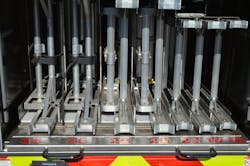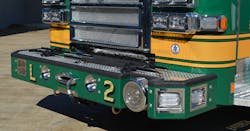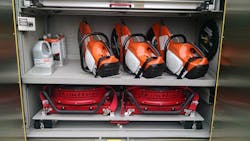The Apparatus Architect: Outfitting & Equipping Your Aerial Apparatus
Today, fire departments have a wide assortment of aerial apparatus from which to choose to protect their communities. These include rear-mount aerial ladders, mid-mount and rear-mount tower ladders and tractor-drawn aerials as well as a number of articulating platforms.
Each of these aerial devices requires a specific chassis configuration to permit the aerial or tower ladder to operate within the parameters for tip-load and platform weight ratings, both dry and with flowing water.
Whether on a single- or tandem-axle chassis, enclosed compartment space is among the most expensive apparatus storage area. Determining the appropriate make and model of an aerial apparatus depends on numerous factors, including: response-district demographics; building heights and setbacks; street configurations; overhead restrictions, including bridges and overpasses; and state regulations that pertain to vehicle axle weights. Fire station apparatus bay space and acquisition costs also must be taken into consideration to determine the appropriate aerial apparatus for your community.Weighty matters
After determining the mission of the apparatus, consider that ladder trucks that are outfitted as quints often suffer from competing space to accommodate the water tank, hose storage and transverse space for tools and equipment. The critical dimension that limits ground ladder banking is the available length that’s inside of the body. For this reason, many apparatus manufacturers prefer to use three-section ladders for 28- and 35-foot extension ladders. Although the retracted length of a three-section ladder affords some benefits, the banking thickness requires more space. The weight increases as well. (For example, a two-section, solid-beam, 35-foot ladder weighs 139 lbs.; a three-section, 35-foot extension ladder weighs 170 lbs. In the case of a truss-style ladder, which often is favored by some departments, a two-section, 28-foot weighs 118 lbs., and a three-section version weighs 154 lbs.)
One of the primary responsibilities of ladder companies is to provide sufficient ground ladders to protect and cover multiple sides of a building that can’t be covered by the aerial apparatus. Depending on building location and means of egress for aerial apparatus, it might be required to have multiple portable ladders on each side of the structure. For this reason, the NFPA 1901: Standard for Automotive Fire Apparatus minimum ground ladder requirement of 85 feet of ground ladders on a quint and 115 feet on an aerial apparatus probably won’t be sufficient to properly cover multiple sides of a structure.
Ground ladders typically are stored on beam or flat within the aerial torque box; however, on quints, ground ladder storage can be limited by the waterway piping, hose bed and water tank. Options for providing additional ground ladder storage include side-body ground ladder mounting, running the waterway outside of the torque box and mounting a roof ladder on the base section of the aerial. Carrying a roof ladder within the ladder or tower fly section might increase the overall height of the vehicle and would reduce the clearance within the ladder handrails for personnel.Tool time
Before setting out to choose the preferred style of aerial device, it’s imperative that the apparatus committee develop a comprehensive fire/rescue tool and equipment inventory that the new apparatus will be required to carry. The tool and equipment inventory will be utilized by the apparatus manufacturer to develop the vehicle-weight analysis. Although NFPA 1901: Standard for Automotive Fire Apparatus (table 12.1.2) provides for an equipment allowance of 2,500 lbs., this might not be sufficient for every truck company apparatus, with some units carrying more than 4,000 lbs. of tools and equipment.
A single-axle aerial quint is susceptible in particular to overweight conditions because of the combination of hose, engine company appliances, water tank and other components. This increases the importance of a department’s scrutiny of exactly which tools and equipment are necessary to enable the crew to safely and effectively carry out the mission.
Depending on local preference, the cab interior and front bumper can provide areas where frequently utilized forcible-entry tools, water extinguishers, gas meters and EMS jump bags can be mounted and secured (within compartments or via 9G-rated brackets). That said, with the current trend to operate with clean cabs, alternative locations must be found to secure these tools. The deck on top of the front bumper extension can be used to mount 6-foot hooks; exterior cab compartments can be utilized for storage of water extinguishers and irons. Other long-handle tools can be carried in the transverse area under the forward-facing seats, for rapid access by crew members.
When developing your tool and equipment list, it’s beneficial to review past incidents to identify the frequency of use for each piece and to determine whether the tool needs to have space that’s dedicated to it on the new apparatus. You might carry out this determination by assigning a number from 1–5, with 5 being a critical tool that’s utilized on every run, and 1 being a seldomly used tool (perhaps replaced by another piece of equipment). A numerical value for each item helps to determine the relative value of the tool for inclusion on the new apparatus.
Technology has advanced the design of smoke ejectors and battery-powered tools, such as reciprocating saws, drills and scene lighting, so they require less compartment space. However, they might need to have space to account for charging provisions for battery packs.
Battery-powered extrication tools have become more common on truck company apparatus. When compared with hydraulic rescue tools, such as spreaders and cutters, battery-powered tools tend to be larger and require different mounting arrangements.
Whether the apparatus has a hinged door(s) or rollup shutter doors, all tools need to be mounted and secured within the body compartments. Using a combination of adjustable shelves, slide trays and tool boards, sufficient space should be provided for all current equipment inventory, with a minimum of 15 percent of the body cube left open for future expansion.First and foremost
Truck companies are responsible for a variety of duties on the fireground, including forcible entry, search, rescue, ventilation, utility control and salvage, among others. Depending on the extent of other special service apparatus that’s available in the department fleet, the extent of the equipment that’s carried might vary. Whatever the case, the importance of carrying sufficient ground ladders on the ladder truck is the primary function of the apparatus and should be considered early in the design process for a new apparatus.
About the Author

Tom Shand
TOM SHAND, who is a Firehouse contributing editor, is a 36-year veteran of the fire service. He works with Michael Wilbur at Emergency Vehicle Response, consulting on a variety of fire apparatus and fire department master-planning issues. Shand is a member of the Firehouse Hall of Fame.
Michael Wilbur
MICHAEL WILBUR, who is a Firehouse contributing editor, retired as a lieutenant in FDNY, where he was last assigned to Ladder Company 27 in the Bronx. He has served on FDNY's Apparatus Purchasing Committee and consults on a variety of apparatus-related issues around the country. Wilbur is a member of the Firehouse Hall of Fame. For further information, access his website at www.emergencyvehicleresponse.com.




